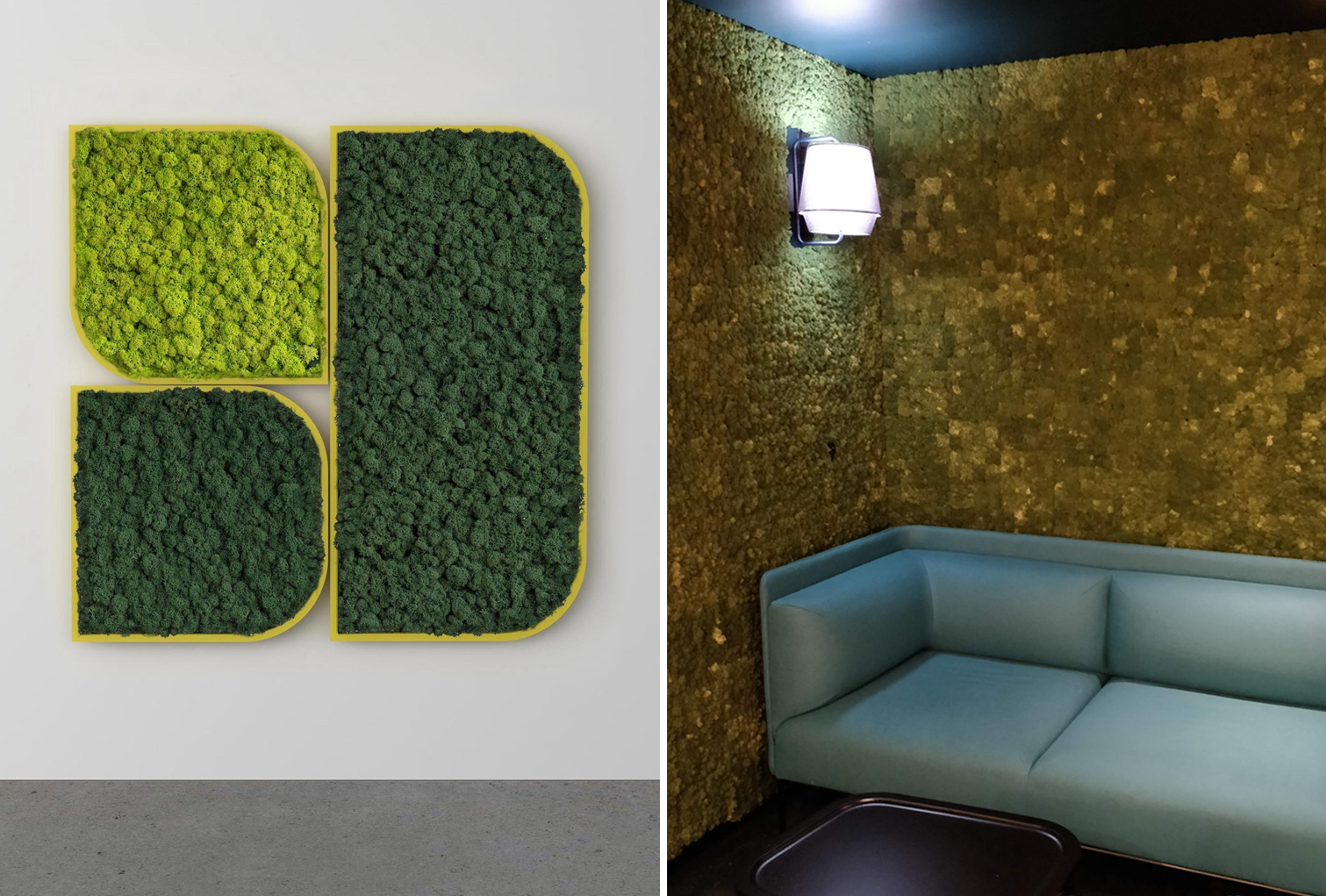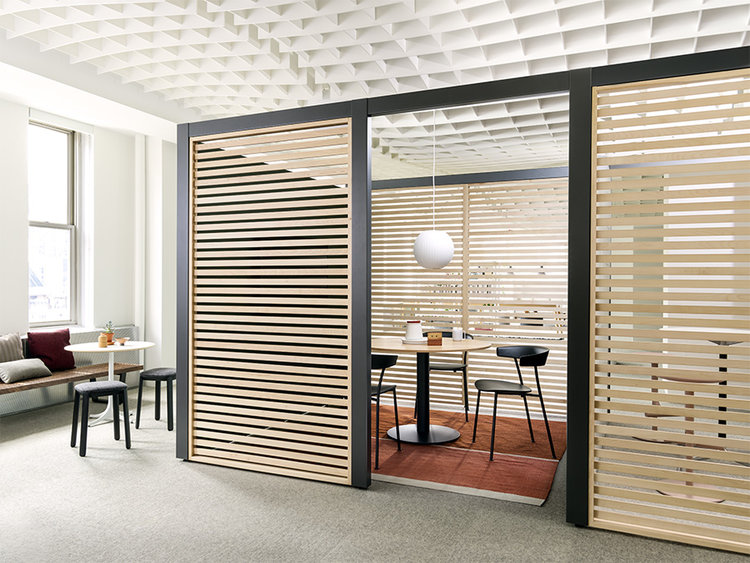Here’s What the Workplace of the Future Looks Like

Architizer arrived in Chicago this week for a particularly special edition of NeoCon, the world’s most important exhibition for commercial design. This year marked the 50th anniversary of the famous trade show, and Chicago’s iconic Merchandise Mart was buzzing with as much activity as ever: Thousands of manufacturers showcased a wide variety of contract furniture and interior design solutions for commercial settings, from internationally renowned brands to innovative new design studios.
Here, we take a broad sweep of the NeoCon showrooms to pick out key commercial design trends to watch out for in the year ahead. Looking at everything from materials and color to aesthetics and acoustics, the following themes serve to give you a glimpse of what the workplace of the near future could look like:

Left: Ginkgo Ply Lounge chair by Davis Furniture; right: The Muse chair by Davis Furniture; photography by Paul Keskeys

Kiik modular furniture by Arper; photograph © Bob Coscarelli
Commercial Style — Residential Comfort
Davis Furniture exemplified the trend towards warm woods and soft textures in commercial furniture design, showcasing a series of conference and lounge chairs that appear elegant and relaxed in equal measure. The Ginkgo Ply Lounge chair by Jeths+Laub sports a wood back that flexes gently as you lean back, with a comfortable form that verges on the residential. The Gingko Conference seat boasts a similarly elegant silhouette. Meanwhile, Muse is a soft, sculptural lounge chair that “embraces the body”, once again striking a balance between comfort and corporate style.
Arper launched Kiik, a modular sofa system designed by Iwasaki Design Studio. The stylish, low-profile furniture — a combination of relaxed seating and side tables of multiple geometries — can be laid out in virtually unlimited variations, ideal for communal areas and waiting rooms.
Taking softness further still, De Vorm’s Nook lounge chair and Pod privacy chair are built from a special felt material, providing a strong but comfortable cocoon-shaped seat. The felt possesses good acoustic properties and is highly moldable, allowing the company to press it into seamless, curved forms that channel a calm office atmosphere.

Emeco 1 Inch Recycled Chair; left photograph via Emeco, right by Paul Keskeys

Left: BuzziMood by BuzziSpace, image via BuzziSpace; right: Pixel green wall by Scandinavian Spaces; photograph by Paul Keskeys
Eco Chic
De Vorm’s fuzzy creations also feed into another growing trend on show at NeoCon 2018 — that of sustainable design. The durable felt shell of each product is made of recycled PET bottles, and is recyclable itself. More material innovation was showcased by Emeco, whose 1 Inch Reclaimed Stacking Chair is crafted from 90% recycled industrial waste. The wood polypropylene chairs are resilient enough for outdoor use and available in eight colors.
The environmental trend extended from the furniture to the walls thanks to BuzziSpace. The Netherlands and U.S-based brand revealed BuzziMood, a “biophilic” acoustic panel made from reindeer moss. Designed by Cory Grosser, BuzziMood includes light and dark green moss options and is offered in a variety of color-contrasting metal frames, allowing for endless compositions on the wall. Meanwhile, Scandinavian Spaces showed off Pixel, another reindeer moss acoustic product designed to dampen sound with an organic aesthetic.

Sherwin-Williams’ Naturalist color palette, featuring hot pink; image via Sherwin-Williams

In the hot (pink) seat, from left to right: Mila chair by 9to5 seating; BuzziPuzzle by BuzziSpace; Hush chair by noughtone; photographs by Paul Keskeys
The Future is Fuschia
Paint manufacturer Sherwin-Williams used NeoCon revealed their 2019 Colormix Forecast, a range of color palettes for contemporary spaces inspired by all aspects of nature from the desert and the rainforest to earth and outer-space. One of their stand-out palettes is named Naturalist, notable for its contrasting pop of fuschia amidst a range of earthy, mushroom tones.
Hot pink is clearly a color to watch across interior design in the coming months: The same intense hue was present in the realm of commercial seating courtesy of 9to5 Seating; the manufacturer threw the spotlight on vivid versions of its sleek Mila and Mimi office chairs. Not to be out-done, British furniture designer noughtone’s showroom was full of color, including a mottled pink version of the Hush wing-backed chair, another seating design that strikes a balance between residential comfort and commercial style.
Buzzispace joined in the fuschia fun with a pink and purple rest spot in the shape of Buzzipuzzle, a playful series of interlocking, sound-balancing seats suitable for everywhere from break-out office spaces to children’s play areas. Perhaps the most vibrant showroom of all, though, belonged to Scandinavian Spaces — the Nordic designers presented pleasantly rounded furnishings in green, yellow and — you guessed it — pink (pictured in the hero image of this article), resulting in a space full of psychedelic style.

Left: Jabbrrbox’s permanent pods at Chicago’s Merchandise Mart; right: Framery’s individual work pod; photographs by Paul Keskeys

Overlay sub-architectural walls by Herman Miller; photograph © Fran Parente
Rise of the Work Pods
Fighting back against the open plan office craze of the early 2000s, sound-insulated pods are growing in popularity, and they were all the rage at NeoCon. Jabbrrbox now has a permanent installation in the Merchandise Mart, offering an acoustic refuge on a pay-for-access basis. The brand’s resilient shell and payment technology makes it an ideal fit for public spaces like airport terminals and train stations. For the office itself, Framery offers a number of pods at different sizes, each one sporting attracted filleted corners and soft colors.
As well as fully-sealed pods, there were a number of innovative variations on partition systems that allow companies to segment open plan offices with improved acoustics and privacy. These included Herman Miller’s Overlay, a modular series of “sub-architectural walls” that offer a way to enclose portions of an office with high style and at low cost. Designed by Ayse Birsel and Bibi Seck, Overlay channels urban planning principles, facilitating a mix of communal and private spaces using a plethora of different materials.

Geiger’s Axon Table; images via Herman Miller

Left: Formica’s charging surface; right: Tandus Centiva’s graphic synthesizer-generated vinyl tile and carpet; photographs by Paul Keskeys
Technological Marvels
Integrated technology featured highly in the creation and application of a wide variety of products throughout NeoCon. Geiger showcased its sleek Axon conference table with built-in ports that provide all the power you need, without diminishing the minimalist aesthetic of the contemporary office. Designed by Japanese pioneers Naoto Fukasawa and Keiji Takeuchi, the tables are available in veneer, laminate, back-painted glass, stone and quartz finishes.
Meanwhile, Formica debuted a wireless charging laminate countertop that allows you to charge your mobile phone simply by placing it upon the surface. The surface is also microbe resistant, scratch resistant, and possesses self-healing properties.
Finally, Tandus Centiva’s latest luxury vinyl tile (LVT) was produced using innovative graphic synthesizer technology. Its digitally manipulated patterns provide subtly futuristic visuals ideal for large expanses of flooring, while cleverly camouflaging the scuffs and scrapes of high traffic spaces. The same technology was used to produce a multitude of carpet designs that tile with no visible repetition and perfectly seamless joints.
The post Here’s What the Workplace of the Future Looks Like appeared first on Journal.
, Paul Keskeys, read more Journal http://bit.ly/2MqPiA5
Yorumlar
Yorum Gönder